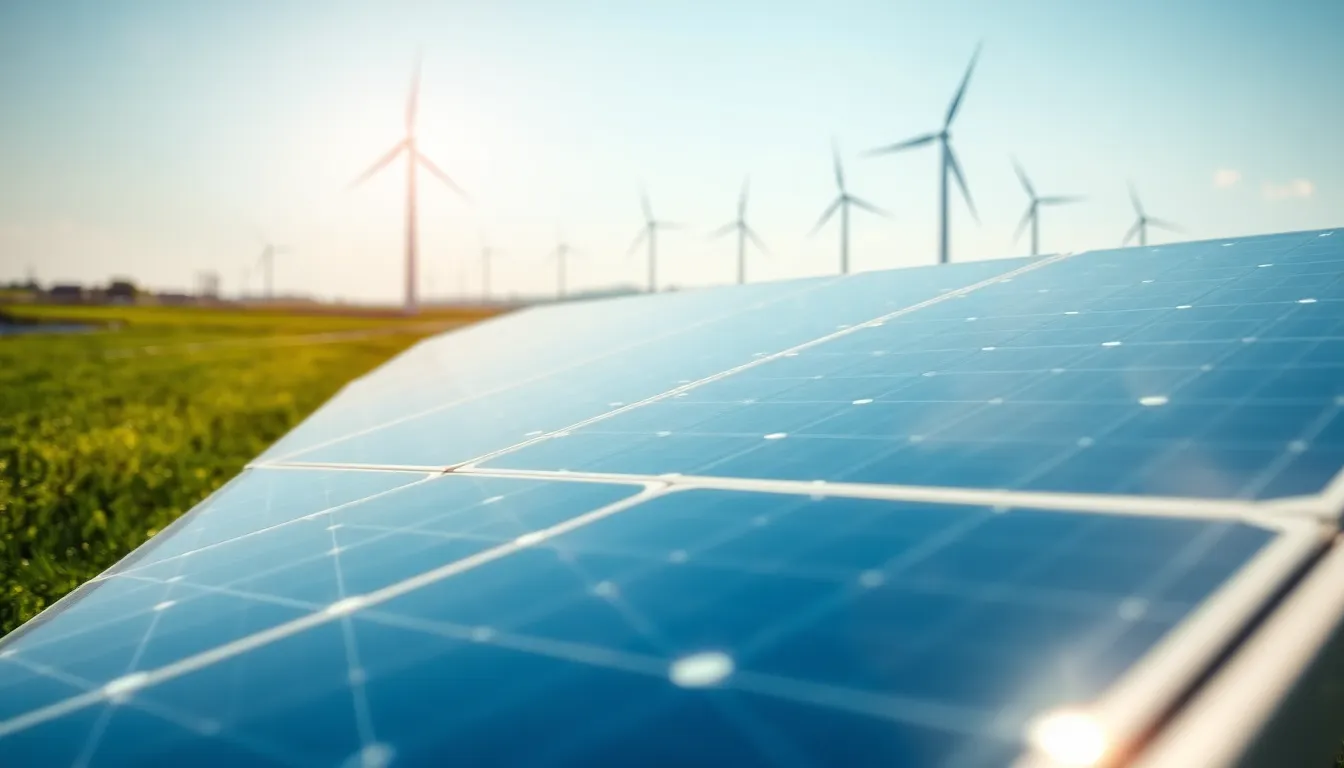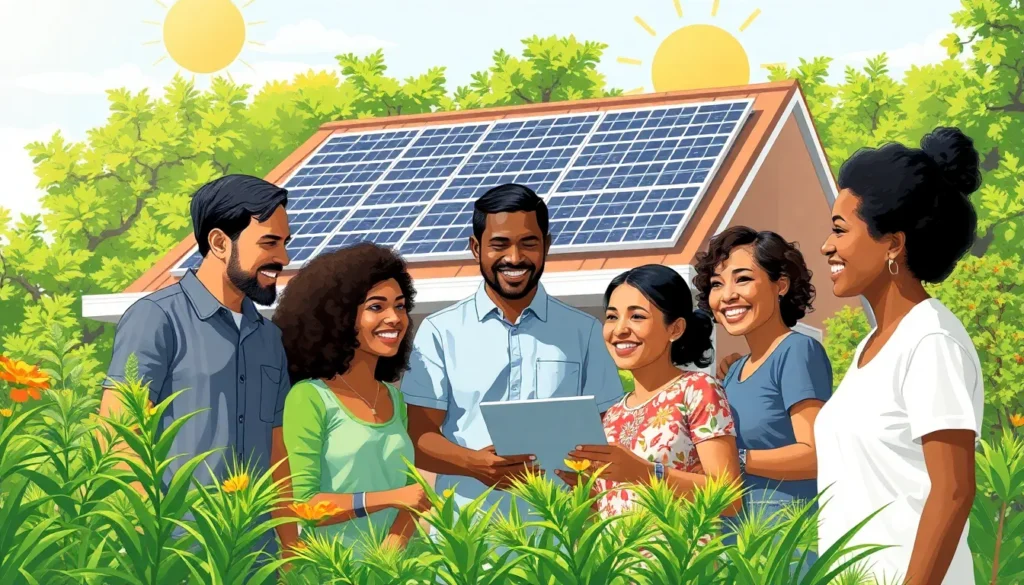Table of Contents
ToggleIn a world where the planet’s health often feels like a game of Whac-A-Mole, green tech innovations are the superheroes we didn’t know we needed. These groundbreaking advancements are not just saving the Earth; they’re making it a cooler place to live. Picture solar panels that double as art and wind turbines that could outshine your neighbor’s lawn gnome.
Overview of Green Tech Innovations
Green tech innovations focus on sustainable solutions that reduce environmental impact and improve resource efficiency. These technologies include solar energy systems, energy-efficient appliances, and advanced waste management strategies.
Solar panels demonstrate significant evolution, featuring aesthetics that blend with architecture while generating clean energy. Companies, like Tesla, have introduced solar roofs that function as both roofing materials and power generators. Energy-efficient appliances, such as smart thermostats, optimize electricity usage and minimize utility costs.
Electric vehicles (EVs) represent another critical advancement, with major manufacturers rolling out models that boast longer ranges and faster charging times. According to the International Energy Agency, global electric car sales reached 2 million units in 2020, reflecting a growing shift toward sustainable transportation.
Moreover, smart grids enhance energy distribution, allowing real-time adjustments to electricity supply based on demand. Countries investing in smart grid technology experience reduced energy waste and improved reliability.
Innovations in waste management, such as anaerobic digestion and composting, enable municipalities to convert organic waste into useful biogas. This process not only reduces landfill volume but also generates renewable energy, supporting local energy needs.
Researchers are also exploring alternatives to conventional materials. Biodegradable plastics made from plant-based sources aim to minimize environmental harm while maintaining functionality. Initiatives focusing on circular economy practices emphasize reducing material waste and promoting recycling.
Green tech innovations encompass diverse solutions aimed at tackling environmental issues and promoting sustainability. Collaborations among governments, businesses, and academic institutions fuel this dynamic field, enhancing the quality of life for current and future generations.
Types of Green Tech Innovations

This section highlights various categories of green tech innovations crucial for environmental sustainability.
Renewable Energy Solutions
Solar energy systems generate clean electricity by converting sunlight through photovoltaic cells. Wind power harnesses the kinetic energy of wind using turbines to produce renewable energy. Hydropower utilizes flowing water to drive turbines, offering a reliable energy source. Geothermal energy taps into the Earth’s heat for heating and electricity. Biomass energy converts organic materials into biofuels, reducing dependency on fossil fuels. These solutions play a significant role in reducing greenhouse gas emissions and promoting energy independence.
Sustainable Transportation
Electric vehicles (EVs) serve as a major advancement in sustainable transportation, enabling lower emissions compared to traditional vehicles. Public transit systems, like electric buses and trains, also contribute to reducing urban congestion and pollution. Bicycles and electric scooters promote eco-friendly commuting options that help decrease carbon footprints. Carpooling and ride-sharing platforms optimize vehicle usage, leading to fewer cars on the road. Innovations like hydrogen fuel cell technology support the transition to cleaner alternatives in heavy transport, enhancing overall sustainability.
Energy Efficiency Technologies
Energy-efficient appliances utilize less electricity while providing the same level of service, reducing utility bills and energy consumption. Smart home technologies enable users to monitor and control energy use effectively, maximizing savings. LED lighting significantly decreases energy required for illumination, lasting longer than traditional bulbs. Building insulation materials improve energy retention, minimizing heating and cooling needs. Automation systems regulate energy flow for heating, cooling, and lighting, increasing overall efficiency in buildings.
Impact of Green Tech Innovations
Green tech innovations significantly influence environmental sustainability and economic growth. They play a vital role in mitigating climate change and fostering a greener economy.
Environmental Benefits
Green tech innovations reduce greenhouse gas emissions significantly. Solar, wind, and biomass energy sources help decrease dependence on fossil fuels. Moreover, advancements in energy-efficient technologies, such as smart home devices and LED lighting, optimize energy use and minimize waste. Another critical aspect includes innovations in waste management, which convert organic materials into renewable energy. Enhanced recycling methods and biodegradable plastics also contribute to less pollution, benefiting ecosystems. In summary, these environmental advantages lead to improved air quality and healthier communities.
Economic Advantages
Economic growth results from implementing green tech innovations. Investments in renewable energy create jobs in manufacturing, installation, and maintenance sectors. The proliferation of electric vehicles contributes to decreasing fuel costs and promoting energy independence. Smart grid technology optimizes energy distribution, reducing operational costs for utilities and consumers alike. Additionally, energy-efficient appliances lower utility bills, providing savings for households. Overall, the economic advantages of green tech bolster initiatives aligned with sustainable development.
Challenges Facing Green Tech Innovations
Green tech innovations face several challenges that hinder their widespread adoption and effectiveness.
Technological Barriers
Technological barriers often impede the development of green tech solutions. Energy storage remains a significant issue for solar and wind technologies, as current battery technologies struggle to provide sufficient capacity. Many companies invest heavily in research but encounter difficulties in scaling their innovations. Limited integration of smart technology in existing infrastructures also complicates adoption. High upfront costs deter consumers and businesses from switching to green alternatives. Additionally, the rapid pace of innovation sometimes leads to compatibility concerns among different technologies.
Policy and Regulation Issues
Policy and regulation issues significantly impact green tech advancements. Conflicting regulations can create confusion for businesses and hinder innovation progress. Many governments still favor fossil fuels through subsidies, making renewable energy solutions less competitive. Inconsistent policies across regions can complicate investments in green technologies. Furthermore, the slow pace of regulatory approvals limits the deployment of new technologies. Stakeholders often face challenges in navigating complex environmental standards, impacting their ability to innovate effectively. These regulatory hurdles ultimately slow down the transition to environmentally sustainable practices.
Future Trends in Green Tech Innovations
Innovations in green technology continue to evolve, addressing urgent environmental issues while enhancing societal well-being. Emerging trends showcase the potential for significant sustainable advancements.
Emerging Technologies
Innovative solutions in green technology focus on harnessing renewable resources. Companies are developing breakthrough solar panel designs that blend aesthetics with functionality. Wind turbine technology is also progressing, making these installations not only efficient but visually appealing. Energy storage systems are gaining traction, improving the reliability of renewable energy sources. Hydrogen fuel cells promise to revolutionize transportation by providing clean energy for heavy-duty vehicles and public transport. Additionally, smart home devices optimize power usage, enabling real-time energy management and promoting efficiency.
Global Adoption Rates
Adoption rates of green technologies are rising globally, reflecting increasing awareness of climate change and sustainable practices. In 2022, about 20% of new car sales in the U.S. were electric vehicles, up from 10% in 2021. Solar energy installations have surged, with a 30% annual increase in the U.S. market since 2020. Countries like Germany and China lead in renewable energy investments. Over 60% of their energy comes from renewable sources. As nations strive for carbon neutrality, collaboration among governments, businesses, and consumers accelerates this trend, creating a resilient framework for sustainable development.
Green tech innovations are reshaping the future by addressing critical environmental challenges while enhancing quality of life. As renewable energy solutions and sustainable technologies gain traction, they pave the way for a cleaner and more efficient world. The ongoing collaboration among governments, businesses, and consumers is vital for overcoming barriers and accelerating the adoption of these innovations.
With continuous advancements in energy efficiency and sustainable transportation, the path toward a greener economy is becoming clearer. Embracing these technologies not only contributes to environmental sustainability but also fosters economic growth and job creation. The commitment to a sustainable future is stronger than ever, driving the momentum needed for meaningful change.






